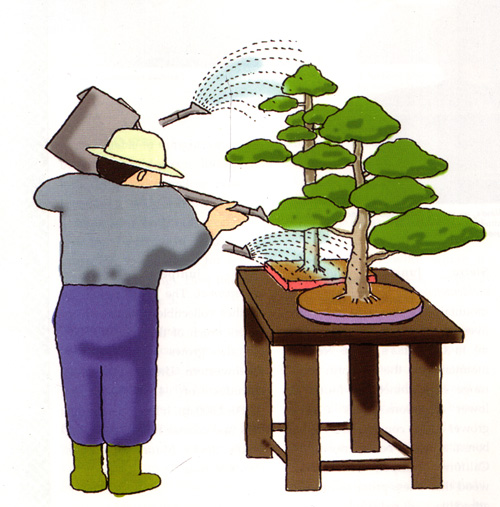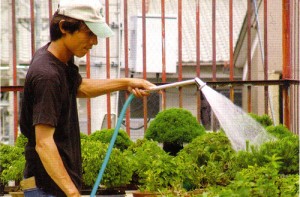 This drawing is from our Masters’ Series book; Junipers, Growing & Styling Juniper Bonsai.
This drawing is from our Masters’ Series book; Junipers, Growing & Styling Juniper Bonsai.
Continuing with our mid-summer archival borrowing program, here’s a post that originally appeared way back in 2009. A perfect complement to this post is a post about summer misting (hamisu) by Michael Hagedorn.
The more you know about watering, the better.
Without timely, intelligent watering, any plant in a container is at risk. The more you know about watering, the better.
But first, a quick word from our sponsor: Check out our big Summer Book Sale at Stone Lantern. 20% to 25% off of our already discounted books.

Photo from Shohin Bonsai by Morten Albek. Published by Stone Lantern.
Over the course of my twelve years as founder and partner of New England Bonsai (now a fading memory), the thing that most amazed me was how little most people knew about watering. Brown thumbs abounded.
This brown thumbed ignorance is, as ignorance does, always looking for easy answers. Don’t confuse me with valuable information, just tell me what to do. Or, in other words “how often do I water?” If this is your question, perhaps the best answer is: “how often do you drink a glass of water?”
Just a little plant science can go a long ways
Plants absorb most of their water and nutrients when the water content of the soil is around 20% to 50% of the available space. Available space is the space in the pot that is not taken up by solid matter. In other words, it is the space that can accommodate water and/or air. This space is found between soil particles and in pockets, holes and cracks within soil particles.
Skip this paragraph if you are easily confused:
Some sources use a percentage of total volume; if the soil takes 50% of the total volume and available space takes 50% (a pretty good ratio for bonsai soil), then you would say optimal water content is 10% to 25% percent of the total volume. This is the same as saying 20% to 50% of the available space.
If you water thoroughly, all the air is driven out of the available space. At that point the water content is 100% of the available space. If your soil drains properly, within a matter of moments, excess water will run out and the available space will contain a mixture of water and air.
Ideally, you want this mixture of water and air to quickly reach around 50% water and then slowly dry down to about 20% water. In other words, you want soil with excellent drainage and with good water retention at the optimal levels.
So, how often do you water?
How long soil holds water at optimal levels depends upon all kinds of things: your soil mix, size and type of pot, sun, heat, wind, temperature, time of year and health of the plant, to name a few. This goes back to the questions “how often do I water?” and “how often do you drink a glass of water?” You water when needed (when the soil is almost dry) and you drink when you’re thirsty.
Soak thoroughly when you water
In order to dispel all the old stale air and to assure the soil is thoroughly watered, make sure you soak the soil when you water.
Then wait until it’s almost dry to water again
To assure that the water/air mixture goes through the optimal range for water and nutrient retention, wait until the soil is almost dry before you water again (there are occasional exceptions, but that’s for another time).
Soil is key
So, for the two of you who have read this far, it should be clear that good soil is one of the keys to bonsai health. Without complicating matters by going into the numerous soils on the market, suffice it to say, if the soil you are using doesn’t allow for good drainage while providing some water retention at optimal levels, then it’s time to try a better soil.
Thanks Wayne. I like and support posts like this one!
Thanks for the information. I notice in the picture of the man watering, he has a broad sprinkling can and is watering the leaves. Any advice on watering leaves?
Good post, Wayne; very clear and to the point. I’m going to plagiarize that “How often do you drink a glass of water?” (You’ve been warned.)
Thanks for pointing your readers to Michael Hagedorn’s items on hamisu (I found two.) I posted excerpts on my own blog, with attribution, of course.
Hi Joe,
Watering leaves is nature’s way.
Some people in very hot sunny climes avoid watering leaves during the hottest hours because of the possibility of leaf burn. But that doesn’t seem to be an issue here in northern Vermont.
Thank you for the comments on watering. I live in an extremely hot climate with a fairly strong wind blowing off of a hypersaline lagoon. Talk about watering problems! I have found that keeping a water meter in hand is the only way to determine when to water. As to soil mix; I’m still working on that one.
Jerry Meislik is a retired eye doctor who had to learn a lot about lenses. From his experience, he states categorically that a rain drop on a leaf cannot focus the sun’s rays so as to cause a burn.
Thanks Steve,
I think Jerry is on to something. I’ve heard this story about leaf burn many times over the years but have never seen an example, except perhaps summer leaf spots on Japanese maples that have caused me to wonder.